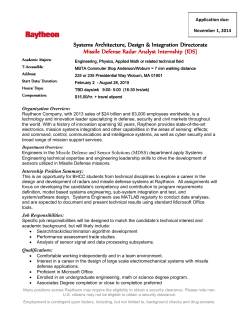
optimising missile defence architecture
CAPS INFOCUS 18 MAR 2015 www.capsindia.org OPTIMISING MISSILE DEFENCE ARCHITECTURE: DISTRIBUTED WEIGHTED ENGAGEMENT SCHEME (DWES) IN AEGIS SEA BASED BMD SYSTEM Arjun Subramanian P Associate Fellow , CAPS Defence against ballistic missiles is still a technologically complex task despite numerous advancements in radar and interceptor technology. A myriad number of factors come into play in intercepting a ballistic missile warhead in flight. Primary among this is the very high warhead velocity. Other major factors are detection, identification, classification, warhead discrimination and tracking. None of the BMD systems currently in existence offer complete protection against incoming ballistic missiles. However, the sea based US Aegis BMD system has proved to be most successful against SRBMs and MRBMs going by the number of successful test engagements and the nature of targets intercepted. As of 6th November 2014, out of 35 test firings, 29 have been successful. These firings include engagements against unitary and separating warheads of SRBMs and MRBMs. There were a total of 12 tests involving MRBM targets, of which 11 have been successful. The one engagement against an IRBM too was successful.i Probably because of the high number of successful test engagements, the radar sensors of the Aegis have been adopted for on-‐shore forward deployments for early warning and target track data relay to the US national missile defence architecture. Very recently another capability, Distributed Weighted Engagement Scheme (DWES) that is being incorporated in the Aegis system, has been successfully tested.ii The DWES is an algorithm that helps in the coordinated engagement decision making involving multiple Aegis equipped Destroyers deployed in a theatre. The algorithm decides, based on the geometry of the BMD nodes and the target position at any given time, on the node that could have the best shot against the incoming warhead. CAPS INFOCUS 18 MAR 2015 www.capsindia.org This prevents unnecessary multiple engagements that could result in the wastage of interceptors. This is appealing looking from the inventory management angle and cost. Coordination of multiple Aegis ships in a theatre provides maximum coverage by increasing the engagement envelope. It also provides multiple aspect angles against the incoming warhead enabling better target-‐decoy discrimination. The system is meant for exo-‐atmospheric interception and the warhead is intercepted in its mid-‐course phase, which is the longest phase of a ballistic missile flight. This provides considerable time for the discrimination function and engagement decision for the fire-‐control system. It is to be noted that the Aegis system is claimed to have a radar range (by elevation) of 1000 km. The Aegis system sports the SPY-‐1 radar which operates in the S-‐band region, which is found to be suitable for performing decoy-‐warhead discrimination. However, x-‐band will have much better performance for this function. Nevertheless, this minor drawback is off-‐set when taking into account US ballistic missile defence philosophy. Going by the deployment pattern, the sensor variants and its networking,iii the US ballistic missile defence philosophy can be clearly seen. It is based on integrating all the sensors and the interceptor platforms, bringing it under the National Missile Defence architecture. Hence, the engagement decision of any ballistic missile in a theatre will involve the analysis of target details collected from multiple sensors tracking the incoming target in real time. Multiple sensors offer multiple aspect angles and also enable precise trajectory projection. The sensors are of different nature operating in different frequency (high to low) and bandwidth, providing multi-‐spectral target information which off-‐sets individual system limitations like the absence of x-‐band sensors in the Aegis system. One of the recent upgrades that contributes tremendously to the US BMD architecture is the deployment of mobile Sea Based X-‐band radar that can be deployed at any part of the globe. The radar has a range of 4000 km in elevation providing higher resolution warhead information which enables better target classification and decoy-‐warhead discrimination in the mid-‐course phase. CAPS INFOCUS 18 MAR 2015 www.capsindia.org Comments • The DWES further compliments the US BMD architecture by providing multiple aspect angles enabling better target identification, classification and decoy-‐warhead discrimination. • The networked deployment pattern provides wider engagement envelop increasing the BMD footprint. • From the inventory and magazine perspective, the system offers optimum utilisation of scarce resources and could suit well against salvo and saturation attacks. • The test data sheet indicates that the test engagements involved separating warheads as well but without any countermeasures being incorporated to the incoming warheads. Takeaways • The system limitations are being overcome by integrating the available resources by way of networking multiple sensors to obtain finer target details for enhanced target classification, discrimination and engagement. This increases the overall kill probability. • US has so far pumped in huge amounts of money in R&D in this domain. • The US is attempting to bring in all the countries that have deployed BMD systems in the regions of its interest into its national missile defence architecture. This hugely helps in cost reduction and further contributes to strengthening its regional security alliance. **** (Disclaimer: The views and opinions expressed in this article are those of the author and do not necessarily reflect the position of the Centre for Air Power Studies [CAPS]) Page Designed By: Kriti Singh, AF, CAPS CAPS INFOCUS 18 MAR 2015 www.capsindia.org -‐-‐-‐-‐-‐-‐-‐-‐-‐-‐-‐-‐-‐-‐-‐-‐-‐-‐-‐-‐-‐-‐-‐-‐-‐-‐-‐-‐-‐-‐-‐-‐-‐-‐-‐-‐-‐-‐-‐-‐-‐-‐-‐-‐-‐-‐-‐-‐-‐-‐-‐-‐-‐-‐-‐-‐-‐-‐-‐-‐-‐-‐-‐-‐xxxxxxx-‐-‐-‐-‐-‐-‐-‐-‐-‐-‐-‐-‐-‐-‐-‐-‐-‐-‐-‐-‐-‐-‐-‐-‐-‐-‐-‐-‐-‐-‐-‐-‐-‐-‐-‐-‐-‐-‐-‐-‐-‐-‐-‐-‐-‐-‐-‐-‐-‐-‐ i http://www.mda.mil/global/documents/pdf/aegis_tests.pdf ii http://www.janes.com/article/49527/aegis-‐bmd-‐test-‐demonstrates-‐automatic-‐engagement-‐co-‐ordination-‐ between-‐ships iii This statement primarily takes into account the East Asian region.
© Copyright 2025















